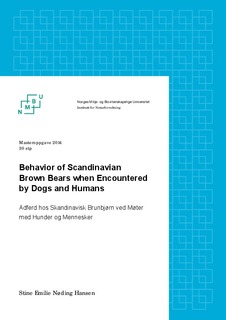| dc.contributor.author | Hansen, Stine Emilie Nøding | |
| dc.date.accessioned | 2015-02-27T11:31:28Z | |
| dc.date.available | 2015-02-27T11:31:28Z | |
| dc.date.copyright | 2014 | |
| dc.date.issued | 2015-02-27 | |
| dc.identifier.uri | http://hdl.handle.net/11250/278009 | |
| dc.description.abstract | The Scandinavian brown bear population was persecuted in the last half of the 1800s and almost
went extinct. They got protected in Sweden in 1927 and in Norway in 1973, and have since
reached a level that can be hunted. The bears choose areas with as little human activity as
possible, but dangerous situations may occur especially during hunting. There have been 32
incidents of bear attacks on humans since 1977, and it is mainly hunters that have been injured by
bears. Many of these situations involved hunting where a dog was chasing and/or baying the bear.
This has made the public question if it is dangerous to bring dogs with when hiking. In this study
I have tried to answer this question and my hypothesis was that bears will have a different
reaction to being startled by humans with dogs compared to being startled by humans with no
dogs. That is that the bears will have a stronger reaction to being startled by humans with dogs.
My first prediction was that a bear will move away from a human with a loose dog at a longer
distance than a human with no dog, and my second prediction was that the bears will be moving
further away from the initial site after being startled by humans with dogs compared to being
startled by humans with no dogs. The study was conducted on the southernmost bear population
in Scandinavia (Dalarna and Gävleborg Län), using a total of 112 approaches, of which 71 was
humans with no dogs and 41 was humans with dogs. I found that my first prediction was true –
that bears moved away from humans with dogs at a further distance than humans with no dogs.
This may be because the dog indicates human presence and gives the bear a chance to move away
before even seeing the human. It may also be because dogs are usually in hunting situation and
the bear moving away from the dog may be necessary for its survival. I also found that my
second prediction of the bear moving further away from initial site when approached by humans
with dogs compared to humans with no dogs was true. A dog will be able to follow a bear further
than a human will, and it may therefore be necessary to move further from a dog than a human to
avoid being discovered again. In conclusion: based on my findings my answer to the public
concerns about bringing their dogs on hikes in areas with bears is that loose dogs do not elevate
the danger for getting into conflicts with bears. | nb_NO |
| dc.language.iso | eng | nb_NO |
| dc.publisher | Norwegian University of Life Sciences, Ås | |
| dc.subject | scandinavian brown bear reasearch project | nb_NO |
| dc.subject | brown bear | nb_NO |
| dc.subject | bear | nb_NO |
| dc.subject | dog | nb_NO |
| dc.subject | encounter | nb_NO |
| dc.subject | human encounter | nb_NO |
| dc.subject | humans with dogs encounter | nb_NO |
| dc.subject | FID | nb_NO |
| dc.subject | flight initiation distance | nb_NO |
| dc.title | Behavior of Scandinavian brown bears when encountered by dogs and humans | nb_NO |
| dc.title.alternative | Adferd hos Skandinavisk Brunbjørn ved Møter med Hunder og Mennesker | nb_NO |
| dc.type | Master thesis | nb_NO |
| dc.subject.nsi | VDP::Mathematics and natural science: 400::Zoology and botany: 480::Ethology: 485 | nb_NO |
| dc.source.pagenumber | 29 | nb_NO |
| dc.description.localcode | M-NF | nb_NO |
